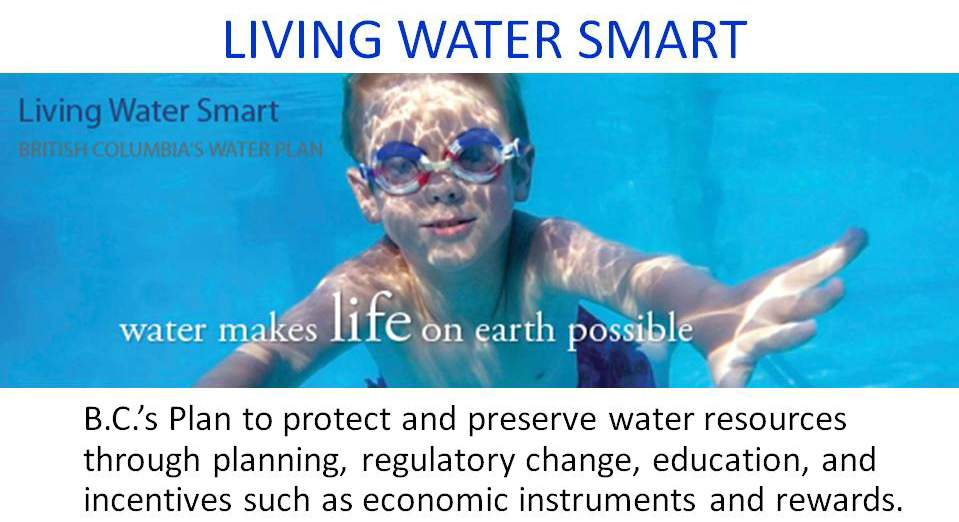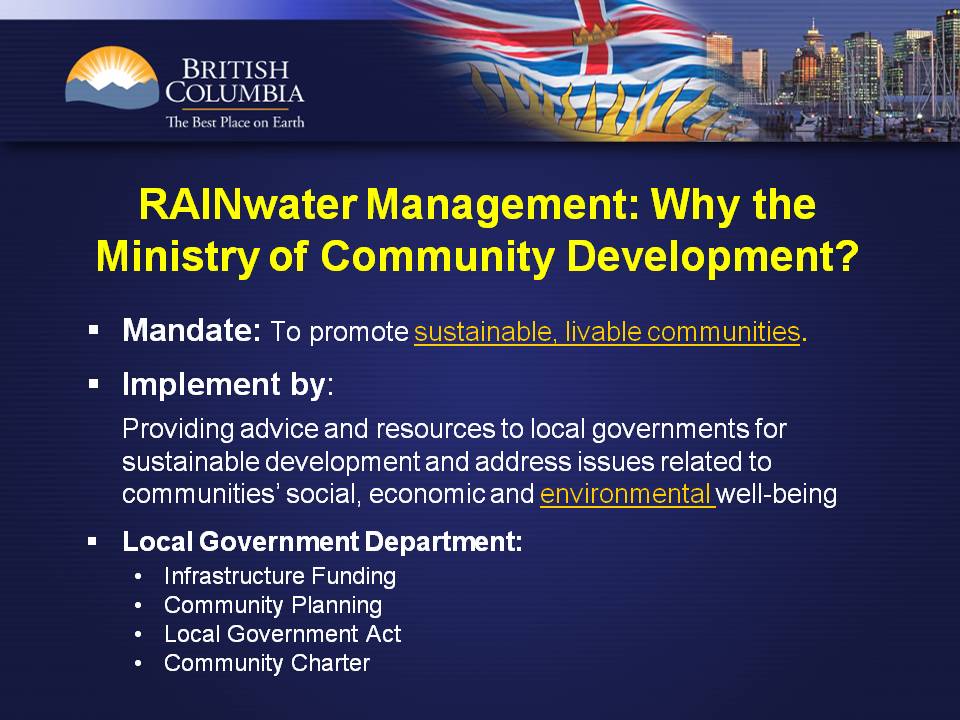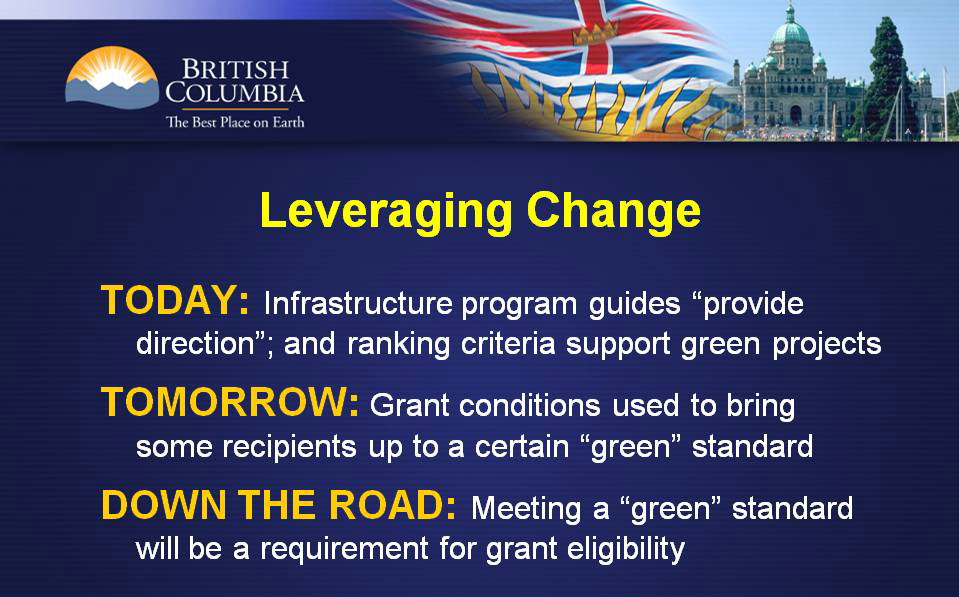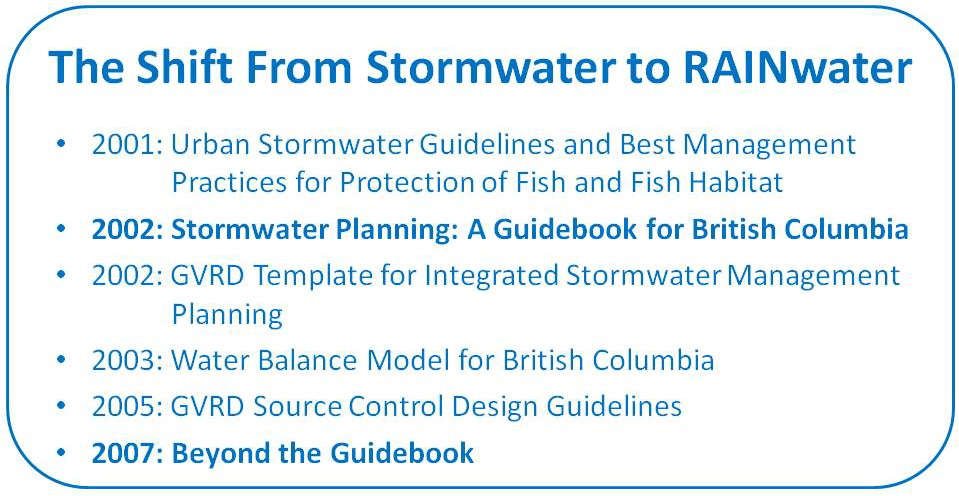SURREY FORUM STORY #5: Provincial Context: Today’s Expectations are Tomorrow’s Standards for Green Infrastructure
Note to Reader:
The Metro Vancouver Water Balance Model Forum was held in Council Chambers at Surrey City Hall on March 12, 2009.
For an overview of the Agenda, click on Lesson Plan – Draft Outline of What We Want to Achieve.
To download a report-style, PDF version of the following web story about the Forum, click on Provincial Context: Today’s Expectations are Tomorrow’s Standards for Green Infrastructure.
The relevance and value of the following web version resides in the embedded links to other Waterbucket resources that elaborate on various aspects of the Surrey Forum storyline.
Convening for Action in the Metro Vancouver Region
How do we simultaneously work together as staff within a municipality and as a region AND externally with developers and other private sector players, to ensure we implement sustainable approaches to development?
The foregoing challenge provides context for advancing a ‘regional team approach’ at the Metro Vancouver Water Balance Model Forum on March 12, 2009. Hosted by the City of Surrey, this learning event is co-sponsored by the Water Balance Model Inter-Governmental Partnership and the Green Infrastructure Partnership.
1. Living Water Smart, British Columbia’s Water Plan
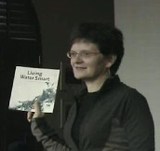 “A provincial policy framework is now in place that enables municipalities to ‘do business differently’ in order to design their communities to live in harmony with water,” states Lynn Kriwoken, Director, Innovation and Planning in the Water Stewardship Division of the Ministry of Environment, and the Province’s lead person for delivery of Living Water Smart, BC’s Water Plan,
“A provincial policy framework is now in place that enables municipalities to ‘do business differently’ in order to design their communities to live in harmony with water,” states Lynn Kriwoken, Director, Innovation and Planning in the Water Stewardship Division of the Ministry of Environment, and the Province’s lead person for delivery of Living Water Smart, BC’s Water Plan,
“By living water smart, communities will be more prepared for climate change and their quality of life will be enhanced.”
The Story of the Surrey Forum
“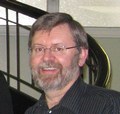 This is the fifth in a series of stories leading up to the Forum, explains Kim Stephens, Program Coordinator for the Water Sustainability Action Plan for British Columbia, “Their purpose is to progressively connect the dots and foreshadow what participants can expect on March 12th.”
This is the fifth in a series of stories leading up to the Forum, explains Kim Stephens, Program Coordinator for the Water Sustainability Action Plan for British Columbia, “Their purpose is to progressively connect the dots and foreshadow what participants can expect on March 12th.”
“This Story #5 describes the parts that Lynn Kriwoken, Karen Rothe, Ray Fung and Vincent Lalonde will play in providing cascading provincial, regional and local perspectives.”
![]()
2. Forum Program – An Overview
 “A key message in Living Water Smart is that green development makes sense,” emphasizes Lynn Kriwoken. “New thinking about development leads to new benefits. These include more green spaces, more water and fish in the streams, improved community vitality, reduced demand for water, and reduced expenditure on infrastructure.”
“A key message in Living Water Smart is that green development makes sense,” emphasizes Lynn Kriwoken. “New thinking about development leads to new benefits. These include more green spaces, more water and fish in the streams, improved community vitality, reduced demand for water, and reduced expenditure on infrastructure.”
Living Water Smart & Making Green Choices
 “The picture described by Lynn Kriwoken provided the rationale for selecting Living Water Smart & Making Green Choices as the title for the Forum,” continues Ray Fung, Chair of the Green Infrastructure Partnership. “The Forum program is built around the HOW question as it pertains to green infrastructure: HOW will the City of Surrey ensure it gets built right; HOW will a consistent regional approach be achieved in Metro Vancouver?”
“The picture described by Lynn Kriwoken provided the rationale for selecting Living Water Smart & Making Green Choices as the title for the Forum,” continues Ray Fung, Chair of the Green Infrastructure Partnership. “The Forum program is built around the HOW question as it pertains to green infrastructure: HOW will the City of Surrey ensure it gets built right; HOW will a consistent regional approach be achieved in Metro Vancouver?”
Starting a Dialogue:
 “The morning and afternoon parts of the program each comprise three modules,” adds Vincent Lalonde, General Manager (Engineering) with the City of Surrey. “The Forum is designed to start a dialogue between policy-makers and project implementers.
“The morning and afternoon parts of the program each comprise three modules,” adds Vincent Lalonde, General Manager (Engineering) with the City of Surrey. “The Forum is designed to start a dialogue between policy-makers and project implementers.
Alignment with Provincial Goals
“We describe Module 4 in the afternoon as the bridge between the morning and afternoon sessions,” explains Kim Stephens. “Because examples inform policy, we decided to do things differently. The focus of the morning session is on the nuts-and-bolts of Surrey green infrastructure design and  construction experience, mainly because the City is moving beyond pilot projects to a broader watershed objectives approach.”
construction experience, mainly because the City is moving beyond pilot projects to a broader watershed objectives approach.”
“In the afternoon, we will look at the big picture and explore how policy and legal tools can help regulators, developers and designers collaborate to ensure responsible outcomes. For the discussion of local actions to be fully informed, we also need to have the provincial and regional context. Hence, the reason why the module titled Today’s Expectations are Tomorrow’s Standards provides the bridge between the morning and afternoon.”
![]()
3. Today’s Expectations are Tomorrow’s Standards
The phrase Today’s Expectations are Tomorrow’s Standards was unveiled by the Ministry of Community Development in November 2007 at the Beyond the Guidebook Seminar. Held in Vancouver, this event was organized by the Green Infrastructure Partnership in collaboration with the Association of Professional Engineers of BC and the Inter-Governmental Partnership.
Green Mandate of the Ministry of Community Development Explained
The seminar was designed to inform local government and land use practitioners regarding the then emerging policy framework and senior government expectations for applying a Beyond the Guidebook approach to land development and watershed management.
According to Karen Rothe, the Ministry’s Manager for Metro Vancouver and Fraser Valley Growth Strategies, and a Ministry representative on the 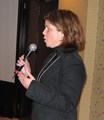 Green Infrastructure Partnership, “At the 2007 Beyond the Guidebook Seminar, we explained why and how the Ministry of Community Development has an increasing role in ensuring that local governments are advancing and changing the ways they plan and design their communities for the better.”
Green Infrastructure Partnership, “At the 2007 Beyond the Guidebook Seminar, we explained why and how the Ministry of Community Development has an increasing role in ensuring that local governments are advancing and changing the ways they plan and design their communities for the better.”
“We also described how the Ministry is using the Green Communities Initiative to advance green infrastructure province-wide. We emphasized that we are slowly raising the bar for local government. For example, we are saying ‘show us what you are doing to protect stream health’. The Ministry is also providing cash awards to recognize the efforts of local governments in achieving design with nature outcomes.”
![]()
4. Beyond the Guidebook: Federal Fisheries Perspective
At the 2007 Beyond the Guidebook Seminar, Corino Salomi of the federal Department of Fisheries and Oceans (DFO) complemented the provincial  presentation with the federal perspective. This coordinated approach resulted in consistency of messaging by the two levels of governments. Corino Salomi is Area Manager, Oceans, Habitat & Enhancement Branch, Lower Fraser Area. He represents DFO on the steering committees for both the Green Infrastructure Partnership and the Inter-Governmental Partnership.
presentation with the federal perspective. This coordinated approach resulted in consistency of messaging by the two levels of governments. Corino Salomi is Area Manager, Oceans, Habitat & Enhancement Branch, Lower Fraser Area. He represents DFO on the steering committees for both the Green Infrastructure Partnership and the Inter-Governmental Partnership.
“We are moving from guidelines to tools,” Corino Salomi noted when introducing the road-map for his presentation. “The purpose of the Beyond the Guidebook initiative is to help local governments and the development community establish what level of rainwater runoff volume reduction makes sense at the site, catchment and watershed scales.”
His presentation provided a perspective on the shift from Stormwater Management to RAINwater Management.
Runoff-Based Approach
“Drainage practice is at a crossroad in the path defining the methodologies and applications used in rainwater management. Beyond the Guidebook makes a clear distinction between a rainfall-based approach and a runoff-based approach. The runoff-based methodology at the heart of Beyond the Guidebook has been incorporated in the new Water Balance Model.”
“The Beyond the Guidebook methodology will allow practitioners to assess both site-level rainwater management measures AND flood relief projects so that they can develop a watershed approach that addresses stream protection and/or restoration. In the process, practitioners will view the watershed and its streams from a much more holistic perspective.”
“We now have the tools and the experience to design with nature and move from stormwater management to RAINwater management”, Corino Salomi stated in his closing remarks. He summarized by emphasizing that the objective is protect stream health, which is broader than how much volume one can infiltrate on a particular development. “While we need to have volume reduction targets, at the end of the day it is how effectively we apply the suite of available rainwater management tools that will ultimately determine whether we will succeed in protecting stream health at a watershed scale.”
![]()
5. Doing Business Differently in BC
“Beyond the Guidebook supports and/or complements other provincial initiatives, notably: Living Water Smart, the Green Communities Project, the Climate Action Plan, Smart Planning for Communities, and A Guide to Green Choices,” observes  Ray Fung. “Collectively, these initiatives establish expectations that, in turn, will influence the form and function of the built environment in general and green infrastructure on the ground in particular.”
Ray Fung. “Collectively, these initiatives establish expectations that, in turn, will influence the form and function of the built environment in general and green infrastructure on the ground in particular.”
“The built environment and natural environment are connected. So, improving the built environment can protect or help restore the natural environment. How we develop or redevelop individual sites has ripple effects at the watershed scale. By designing with nature, this means actions on the ground can result in cumulative benefits over time.”
“To get to the big picture, it starts with the smallest pieces. This is the reason we are placing emphasis on the nuts-and-bolts of Surrey green infrastructure design and construction experience.”
Protecting Stream Health
“Living Water Smart encourages local governments to do business differently, prepare communities for change, and choose to be water smart,” adds Lynn Kriwoken. “The lynch-pin of Living Water Smart is the policy statement found on page 43:
All land and water managers will know what makes a stream healthy, and therefore be able to help land and water users factor in new approaches to securing stream health and the full range of stream benefits.”
“Shifting our focus to stream health requires substantial time and effort on the part of governments, communities, and other partners. Imagine neighbourhoods that have plentiful trees to catch the rain, so water seeps slowly into the ground instead of rushing straight into storm drains and creeks. Imagine neighbourhoods that have fish in the creeks that our kids can catch and eat,” concludes Lynn Kriwoken.
Shared Responsibility
 On March 12, the Surrey Water Balance Model Forum will address this question:
On March 12, the Surrey Water Balance Model Forum will address this question:
So, what does the policy statement on page 43 of Living Water Smart mean to those involved in land development or redevelopment?
“We are approaching the Forum program from a shared responsibility perspective. Everyone will benefit from attending both the morning and afternoon sessions. The policy people will have an appreciation for what is involved in constructing green infrastructure; and the implementers will understand what the provincial, regional and local goals are….and what we are trying to achieve through the use of policy, approved standards, and legal tools,” states Vincent Lalonde.
![]()
6. Regional Alignment
“Shared responsibility is at the core of a regional team approach,” continues Ray Fung. “We all have a role to play in enhancing the quality of life in our own communities, and preparing for climate change. This also means we have an equal responsibility to strive for the common good.”
Partnerships and Collaboration
“To achieve the common good requires bringing together:
- Local government– those who plan and regulate land use;
- Developers– those who build;
- The Province– those who provide the legislative framework;
- Universities and colleges– those who provide research; and
- The stewardship sector – those who advocate conservation of resources.”
“To get to the big picture, it starts with the smallest pieces. This is why the Surrey Forum is advancing a regional team approach that aligns local actions with provincial policy goals. Making this happen requires partnerships and collaboration.”
Creating Our Future
“We see the Forum as providing an opportunity to generate positive energy in the 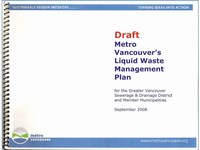 region. In particular, the Forum will inform the actions identified in the rainwater/stormwater component of Metro Vancouver’s updated Liquid Waste Management Plan, states Ray Fung. We believe this is where the ropportunity for implementing a regional team approach resides.”
region. In particular, the Forum will inform the actions identified in the rainwater/stormwater component of Metro Vancouver’s updated Liquid Waste Management Plan, states Ray Fung. We believe this is where the ropportunity for implementing a regional team approach resides.”
““We anticipate that the town hall sharing sessions will show that there are solutions if people talk to each other about what they each could do differently. This will help all parties collaborate to more effectively fulfil their piece of the sustainable development puzzle.”
“Once we know what we want our watersheds and neighbourhoods to look like, the next step is to decide what the tools are that will get us there,” concludes Vincent Lalonde. “All of us ….whether we are regulators, developers or designers ….need to understand and care about the goal if we are to create the future that we all want.”




